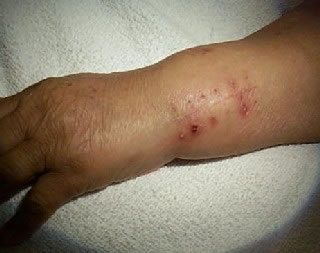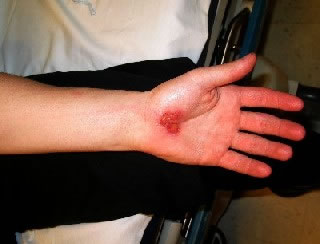Photos

Wound Infection - Suture Site
There is a pimple where a stitch comes through the skin. The pimple suggests a low-grade infection.
Source: Self Care Decisions, LLC
Used with Permission from Schmitt Pediatric Guidelines LLC.

Impetigo of Elbow
This shows impetigo on the elbow. Impetigo is a skin infection caused by bacteria. The infection causes a red sore which leaks fluid. This area will then dry and become crusty as it heals.
Source: Wikimedia Commons
Permission is granted to copy, distribute and/or modify this document under the terms of the GNU Free Documentation License. This is a public domain image file from Wikimedia Commons. Wikimedia is a freely licensed media repository.

Lymphangitis of Left Forearm
If you look closely at this photo, you should be able to see a red streak (lymphangitis) spreading from the hand wound up into the arm.
The presence of lymphangitis means that there is an infection that needs urgent antibiotic treatment. It may require a hospital stay for treatment.
Source: Self Care Decisions, LLC
Used with Permission from Schmitt Pediatric Guidelines LLC.